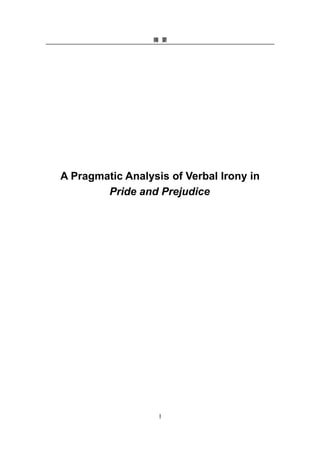
A Pragmatic Analysis of Verbal Irony in Pride and Prejudice
- 1. 摘 要 A Pragmatic Analysis of Verbal Irony in Pride and Prejudice I
- 2. 摘 要 摘 要 反讽对文学作品中人物性格塑造极其重要,简·奥斯汀的小说《傲慢与偏见》 (1813) 就是典型。本研究针对会话分析提出了一种较切实可行的研究方法,即通 过分析说话人意图和对听话人理解的预期,研究反讽对人物性格塑造的作用。 塞尔的言语行为理论(1979)基于说话人意图将说话方式划分为五种言语行 为。由于宣告性言语行为理论受限于言辞外权威因素,本研究用巴特勒的施为性 言语行为理论(1990)取而代之。施为性言语行为理论在保留语句分类功能的同 时,使性格塑造的研究方向由研究言语行为的施为性转向研究说话人意图。塞尔 (1979)和奥斯汀(1962)提出的言语行为理论的适切性条件指明了语句中反讽 的所在。回声理论的影射(斯珀泊与威尔逊,2012)则考虑了反讽的客观分类, 将听话人理解作为检测反讽效果的依据,因为只有听话人充分理解说话人意图时 反讽才能达到预期效果。本研究验证了回声影射能够通过反对、中立和赞成三种 预期的分类反映人物性格塑造的假设。这一发现对用反讽塑造人物性格的语篇分 析做出了原创性贡献,即将说话人意图与说话人对听话人理解的预期相匹配的两 层分析方法:先用修正后的言语行为理论对说话人意图进行分类,继而通过三种 回声影射检测说话人对听话人理解的预期。 本研究以巴特勒的理论作为前提,即施为性言语行为最能体现人物性格塑造。 作者对《傲慢与偏见》中主人翁伊丽莎白和达西的 157 个反讽对话中 81 个施为性 言语行为进行了定量研究,通过卡方检验来验证回声分类和性格塑造间的关联性 检验结果发现,施为性言语行为与回声分类的相关性 P 值低于 0.05。这充分证明 我们能够通过回声分类来分析反讽会话,从而更好地理解小说中人物性格的塑造 在分析反讽时,作者同时研究了施事行为和取效行为。在研究取效行为时,不协 调理论(诺里克,2003)强调了回声影射的不适性;而优势理论(莫里奥 , 2009)则被用于反讽目的的分析。 研究表明,《傲慢与偏见》通过反讽体现出了对伊丽莎白和达西性格塑造的 三个阶段:反对为主的阶段,中立为主的阶段和赞同为主的阶段,这恰好与故事 情节主要阶段相吻合。作者通过修改后的言语行为理论和回声理论,辅以不协调 理论和优势理论,深度分析了三个阶段中 81 个反讽的施为性言语行为及相邻语句, 得出如下结论:以反对为主的阶段体现出他们各自对立的社会观;以中立为主的 阶段更关注各自的性格;以赞同为主的阶段则揭示出两个角色情感走向一致。 关键词:言语行为理论;回声分类;反讽;施为性言语行为;性格塑造 II
- 3. Abstract Abstract Verbal irony plays a prominent role in characterization in literary works such as Jane Austen’s Pride and Prejudice (1813). This dissertation proposes a novel pragmatic approach to conversational analysis, accounting for character construction in the presence of discourse irony through speaker intent and hearer uptake. The merit of Searle’s (1979) speech act theory is that it classifies any utterance into one of five speech acts based on speaker intent. Replacing Searle’s declarations with Butler’s (1990) performative speech acts yields improvements, as declarations rely on extralinguistic institutional authority and are thus limited. Performative speech acts supersede declarations, and bring aspects of character construction from performativity into the classification of speaker intent. Modifying speech act theory in this manner preserves the ability to classify any utterance. Searle’s (1979) and Austin’s (1962) felicity conditions from speech act theory indicate the location of irony. To incorporate hearer uptake into the verification of verbal irony, echoic theory’s allusion (Wilson & Sperber, 2012) allows for objective classification of ironies. The hypothesis that echoic allusions depict characterization when utterances are comprised of disagreement, neutral, and agreement groupings is examined. The original contribution herein to discourse analysis of character construction within verbal irony is the two-tiered method of pairing speaker intent with hearer uptake intended by the speaker: first classifying speaker intent via modified speech act theory and then further identifying hearer uptake with echoic allusions of disagreement, neutral, and agreement groupings. Applying a supplementary quantitative approach to the 157 verbal ironies between Pride and Prejudice’s protagonists, Elizabeth and Mr. Darcy, supports this qualitative framework by demonstrating a connection between echoic groupings and characterization. Butler establishes that performative speech acts must amount to and reveal character construction. The other four types of speech acts are necessary to classify ironical utterances but they may or may not portray character construction. It follows from Butler’s claim, therefore, that performative speech acts are the foremost speech act for depicting characterization. This research examines the hypothesis by testing the correlation with the 81 ironical performative speech acts out of 157 verbal ironies using a Chi-squared goodness-of-fit test. III
- 4. Abstract The statistical tests show that ironical performative speech acts correlate with echoic groupings with a p-value of less than 0.05. This vindicates the approach to address character construction by analyzing ironical utterances through echoic groupings. Speech act theory is redeployed in the analysis of illocutionary and perlocutionary acts within the ironical utterances. When examining perlocutionary acts, incongruity theory (e.g. Norrick, 2003) highlights the infelicity of echoic allusions, and superiority theory (e.g. Morreall, 2009) enables analysis of the purpose of verbal irony. Major findings comprise three phases of characterization discovered in Pride and Prejudice between Mr. Darcy and Elizabeth, i.e. disagreement dominant phase, neutral dominant phase, and agreement dominant phase. These three phases of characterization concurrently identify major phases of the plot. Within these three phases 81 ironical performative speech acts along with their adjacent utterances are analyzed in depth via modified speech act theory and echoic theory with support from incongruity theory and superiority theory. Disagreement dominant phase represents their opposing societal views, neutral dominant phase focuses on their individual personalities, and agreement dominant phase reveals the two characters’ emotions to be in accord. Key words: speech act theory; echoic groupings; verbal irony; performative speech acts; characterization IV
- 6. Abstract List of Figures and Tables 6
- 7. Abstract List of Figures and Tables 6